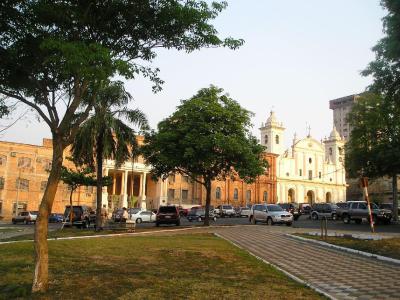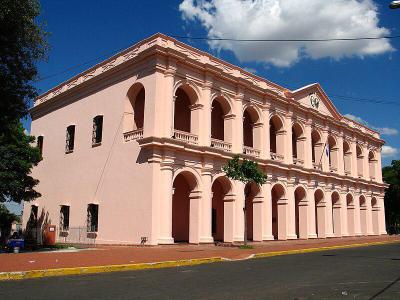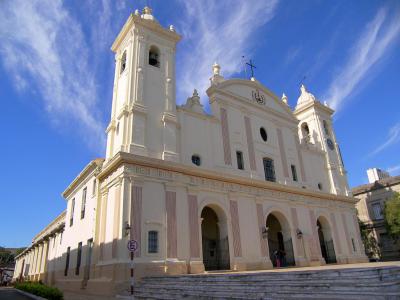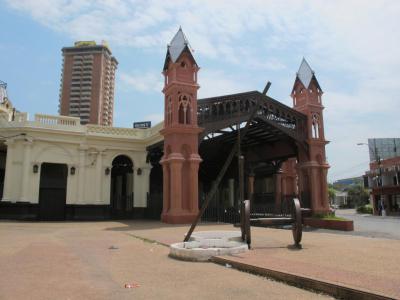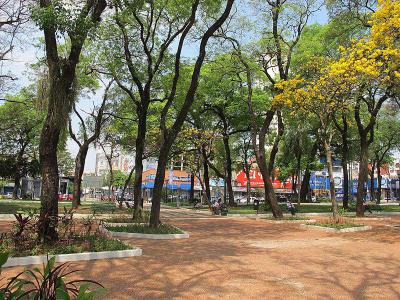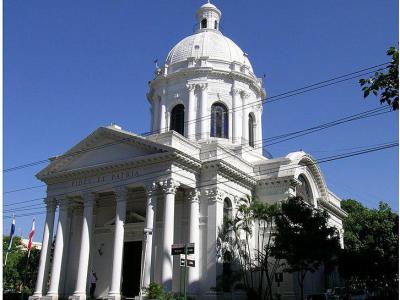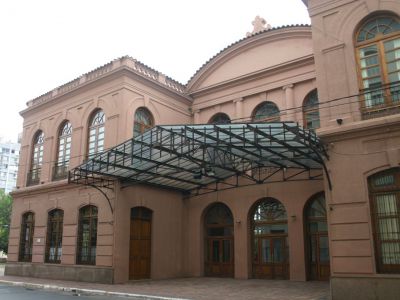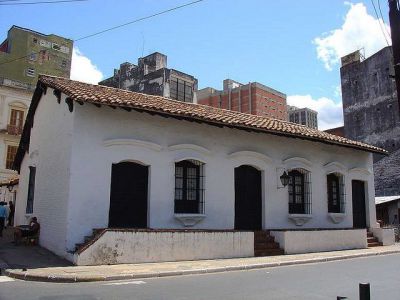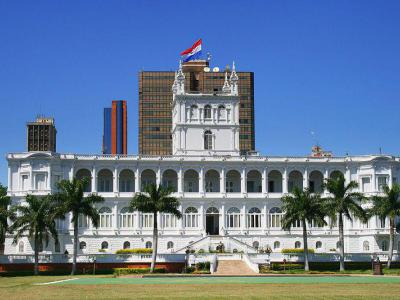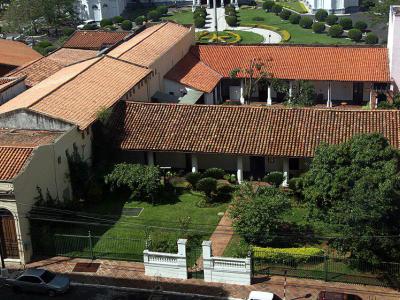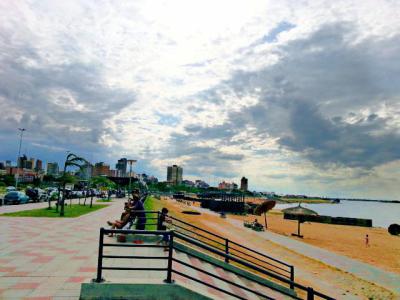Asuncion Introduction Walking Tour (Self Guided), Asuncion
Sitting proudly on the eastern bank of the mighty Paraguay River is the vibrant capital of Paraguay, Asunción.
Established in 1537 by the Spanish explorer Juan de Salazar y Espinosa, this city is one of the oldest in South America. Its official name reads "Nuestra Señora de la Asunción" which means “Our Lady of the Assumption.” The fort that preceded the city was founded on August 15, the day on which the Catholic Church commemorates the Assumption of the Virgin Mary.
Asunción became a provincial center after Buenos Aires in neighboring Argentina was destroyed in 1542. In 1731, a failed uprising foreshadowed the 1811 independence revolt against the Spanish rule. Post-independence, leaders like Gaspar Rodríguez de Francia and Carlos Antonio López drove development, but the Paraguayan War of 1864–1870 caused severe setbacks. Over the 20th century, Asunción evolved into Paraguay's primary urban center, significantly shaping its infrastructure and regional influence.
The heart of Asunción's historical narrative beats strongest in its Old Town, where colonial buildings brush shoulders with modern developments, creating a visual storybook of the city's past and present. Key sites here like the National Pantheon of the Heroes and the House of Independence (Casa de la Independencia) highlight its historical depth.
For a touch of culture, the Manzana de la Rivera neighborhood, located near the Palace of the Lopez (Palacio de los López), showcases architectural evolution through restored traditional homes representing different periods of Asunción’s history.
Lastly, the Costanera de Asunción offers a modern contrast, with its expansive waterfront perfect for leisurely strolls, offering panoramic views of the river, the Bay of Asunción, the city’s skyline, and a breath of fresh air along its well-maintained paths.
For those eager to explore Paraguay's capital where history and modernity converge in a lush, subtropical setting, the gates of Asunción are always open. Our self-guided walk invites you to dive into the city's rich past, vibrant cultural scene, and welcoming atmosphere. Asunción is not just a city to visit; it’s a place to be experienced and enjoyed!
Established in 1537 by the Spanish explorer Juan de Salazar y Espinosa, this city is one of the oldest in South America. Its official name reads "Nuestra Señora de la Asunción" which means “Our Lady of the Assumption.” The fort that preceded the city was founded on August 15, the day on which the Catholic Church commemorates the Assumption of the Virgin Mary.
Asunción became a provincial center after Buenos Aires in neighboring Argentina was destroyed in 1542. In 1731, a failed uprising foreshadowed the 1811 independence revolt against the Spanish rule. Post-independence, leaders like Gaspar Rodríguez de Francia and Carlos Antonio López drove development, but the Paraguayan War of 1864–1870 caused severe setbacks. Over the 20th century, Asunción evolved into Paraguay's primary urban center, significantly shaping its infrastructure and regional influence.
The heart of Asunción's historical narrative beats strongest in its Old Town, where colonial buildings brush shoulders with modern developments, creating a visual storybook of the city's past and present. Key sites here like the National Pantheon of the Heroes and the House of Independence (Casa de la Independencia) highlight its historical depth.
For a touch of culture, the Manzana de la Rivera neighborhood, located near the Palace of the Lopez (Palacio de los López), showcases architectural evolution through restored traditional homes representing different periods of Asunción’s history.
Lastly, the Costanera de Asunción offers a modern contrast, with its expansive waterfront perfect for leisurely strolls, offering panoramic views of the river, the Bay of Asunción, the city’s skyline, and a breath of fresh air along its well-maintained paths.
For those eager to explore Paraguay's capital where history and modernity converge in a lush, subtropical setting, the gates of Asunción are always open. Our self-guided walk invites you to dive into the city's rich past, vibrant cultural scene, and welcoming atmosphere. Asunción is not just a city to visit; it’s a place to be experienced and enjoyed!
How it works: Download the app "GPSmyCity: Walks in 1K+ Cities" from Apple App Store or Google Play Store to your mobile phone or tablet. The app turns your mobile device into a personal tour guide and its built-in GPS navigation functions guide you from one tour stop to next. The app works offline, so no data plan is needed when traveling abroad.
Asuncion Introduction Walking Tour Map
Guide Name: Asuncion Introduction Walking Tour
Guide Location: Paraguay » Asuncion (See other walking tours in Asuncion)
Guide Type: Self-guided Walking Tour (Sightseeing)
# of Attractions: 11
Tour Duration: 2 Hour(s)
Travel Distance: 2.9 Km or 1.8 Miles
Author: karenl
Sight(s) Featured in This Guide:
Guide Location: Paraguay » Asuncion (See other walking tours in Asuncion)
Guide Type: Self-guided Walking Tour (Sightseeing)
# of Attractions: 11
Tour Duration: 2 Hour(s)
Travel Distance: 2.9 Km or 1.8 Miles
Author: karenl
Sight(s) Featured in This Guide:
- Plaza Independencia (Independence Square)
- El Cabildo (Cultural Center of the Republic)
- Catedral Metropolitana (Asuncion Cathedral)
- Museum of the Central Station
- Plaza Uruguaya (Uruguayan Square)
- National Pantheon of Heroes
- Ignacio Pane Municipal Theater
- Casa de la Independencia (Independence House)
- Palacio de Lopez (Palace of the Lopez)
- Manzana de la Rivera (Block of the River Cultural Center)
- Costanera de Asuncion (Asuncion Waterfront)
1) Plaza Independencia (Independence Square)
Independence Square stands as a vibrant hub pulsating with color and energy. Situated in close proximity to Hotel Guarani, the National Pantheon of Heroes, and various shopping centers, this traditional plaza beckons with its array of handicrafts. From mates and light bulbs to key chains, Paraguayan hammocks, leather goods, and indigenous crafts, the square boasts a diverse selection of offerings.
Amidst historical statues evoking bygone eras, visitors can immerse themselves in the rich cultural tapestry of Paraguay. Whether seeking souvenirs like pens, mugs, tereres, or fabrics, numerous vendors cater to every taste and budget. The plaza exudes a welcoming ambiance, inviting all to partake in the exploration of Paraguayan heritage. Handwoven tablecloths, crafted by skilled artisans, adorn the stalls, available for purchase at 180 reais.
Additionally, Paraguayan hammocks offer a tranquil respite amidst the summer heat, alongside intricate nanduti (lacework) and spider-weave imitations. Bargaining is encouraged for those eager to secure the best deals. For an authentic immersion into Paraguayan culture, a visit to Independence Square is indispensable.
Amidst historical statues evoking bygone eras, visitors can immerse themselves in the rich cultural tapestry of Paraguay. Whether seeking souvenirs like pens, mugs, tereres, or fabrics, numerous vendors cater to every taste and budget. The plaza exudes a welcoming ambiance, inviting all to partake in the exploration of Paraguayan heritage. Handwoven tablecloths, crafted by skilled artisans, adorn the stalls, available for purchase at 180 reais.
Additionally, Paraguayan hammocks offer a tranquil respite amidst the summer heat, alongside intricate nanduti (lacework) and spider-weave imitations. Bargaining is encouraged for those eager to secure the best deals. For an authentic immersion into Paraguayan culture, a visit to Independence Square is indispensable.
2) El Cabildo (Cultural Center of the Republic)
The Cultural Center of the Republic is a significant cultural and historical institution. Originally serving as the seat of Parliament until 2004, the Council was transformed into a cultural center to preserve and promote Paraguayan heritage. Inaugurated on May 14, 2004, the center's mission is to strengthen historical awareness and collective memory, enhancing its status as a building of monumental value. The name "El Cabildo" reflects its roots in the Spanish colonial institution that historically granted city status in the region.
The center is a hub of Paraguayan culture, featuring impressive collections that highlight the nation's rich history in music, literature, theater, and dance. Among its notable exhibits are rooms dedicated to sacred art, traditional clay artifacts, and the works of renowned figures like Guido Boggiani and Augusto Roa Bastos.
Inside the Cultural Center, visitors can explore a vast library specializing in works by Paraguayan authors, offering a comprehensive look at the country's literary heritage. The art gallery spaces within The Council showcase a wide array of artistic expressions, reflecting various periods of Paraguayan cultural history. The center's main hall, located on the ground floor, hosts temporary thematic exhibitions and events such as dance performances, theater productions, and concerts, providing a dynamic and engaging environment for cultural enrichment.
The center is a hub of Paraguayan culture, featuring impressive collections that highlight the nation's rich history in music, literature, theater, and dance. Among its notable exhibits are rooms dedicated to sacred art, traditional clay artifacts, and the works of renowned figures like Guido Boggiani and Augusto Roa Bastos.
Inside the Cultural Center, visitors can explore a vast library specializing in works by Paraguayan authors, offering a comprehensive look at the country's literary heritage. The art gallery spaces within The Council showcase a wide array of artistic expressions, reflecting various periods of Paraguayan cultural history. The center's main hall, located on the ground floor, hosts temporary thematic exhibitions and events such as dance performances, theater productions, and concerts, providing a dynamic and engaging environment for cultural enrichment.
3) Catedral Metropolitana (Asuncion Cathedral) (must see)
The Metropolitan Cathedral of Our Lady of the Assumption, commonly known as the Asunción Cathedral, has its origins dating back to 1687, making it one of the oldest religious structures in the region. The cathedral underwent significant reconstruction in the mid-19th century under the direction of architect Carlos Zucchi, resulting in the majestic structure that exists today. The cathedral was inaugurated in 1845 during the presidency of Don Carlos Antonio López and is dedicated to Our Lady of the Assumption, the patroness of Asunción.
One of the cathedral's most striking features is its grand altar, which is adorned with intricate silverwork crafted by Jesuit and Franciscan artisans. This silver decoration enhances the spiritual and artistic appeal of the space, offering visitors a glimpse into the rich cultural and religious history of the region. The altar, along with other religious artworks housed within the cathedral, serves as a focal point for worship and reflection.
The architecture of the Asunción Cathedral reflects a blend of colonial influences, with its robust façade and ornate interior details. Its historical significance, combined with its architectural beauty, makes it a must-visit destination for both locals and tourists alike, offering a serene space for contemplation and appreciation of Paraguay's rich heritage.
One of the cathedral's most striking features is its grand altar, which is adorned with intricate silverwork crafted by Jesuit and Franciscan artisans. This silver decoration enhances the spiritual and artistic appeal of the space, offering visitors a glimpse into the rich cultural and religious history of the region. The altar, along with other religious artworks housed within the cathedral, serves as a focal point for worship and reflection.
The architecture of the Asunción Cathedral reflects a blend of colonial influences, with its robust façade and ornate interior details. Its historical significance, combined with its architectural beauty, makes it a must-visit destination for both locals and tourists alike, offering a serene space for contemplation and appreciation of Paraguay's rich heritage.
4) Museum of the Central Station
The Carlos Antonio López Central Railway Station Museum offers a glimpse into a significant period of Paraguay's history, marked by its pioneering role as the first South American country to embrace railway transportation. Established during the presidency of Carlos Antonio López, this museum showcases remnants from a bygone era, including artifacts salvaged from the 35 stations scattered across the country's interior. Visitors are treated to a journey through time as they explore the museum's old rooms, encountering relics such as telegraphs, telephones, phonophones, administrative documents, and original plans. Notably, the museum also houses the safes once used to safeguard its collection.
Opened in 1861 as the "San Francisco Station," this site stands as a testament to Paraguay's advancement in industry and connectivity. One of its notable treasures is the inaugural locomotive to traverse Paraguayan tracks-a remarkable feat of engineering originating from England a mere 29 years after the advent of steam-powered trains in the early 19th century.
Of particular interest is a meticulously recreated room featuring original train cars, complete with first and second-class seats and furniture from the presidential car. This immersive experience allows visitors to envision the opulence and functionality of early railway travel in Paraguay.
The Central Railway Station is also a remarkable architectural landmark. Constructed in 1861 by the English architect Alonzo Taylor, it features distinctive Neo-Gothic towers that complement the surrounding architectural landscape. A notable recent addition to the station is the balustrade above the cornice, which enhances its aesthetic appeal.
Opened in 1861 as the "San Francisco Station," this site stands as a testament to Paraguay's advancement in industry and connectivity. One of its notable treasures is the inaugural locomotive to traverse Paraguayan tracks-a remarkable feat of engineering originating from England a mere 29 years after the advent of steam-powered trains in the early 19th century.
Of particular interest is a meticulously recreated room featuring original train cars, complete with first and second-class seats and furniture from the presidential car. This immersive experience allows visitors to envision the opulence and functionality of early railway travel in Paraguay.
The Central Railway Station is also a remarkable architectural landmark. Constructed in 1861 by the English architect Alonzo Taylor, it features distinctive Neo-Gothic towers that complement the surrounding architectural landscape. A notable recent addition to the station is the balustrade above the cornice, which enhances its aesthetic appeal.
5) Plaza Uruguaya (Uruguayan Square)
Plaza Uruguaya is one of Asunción’s most beloved public spaces-a refreshing green haven right in the heart of the city. Known for its shady trees, vibrant flowerbeds, and relaxed atmosphere, the square serves as a welcome escape from the heat and the hustle of downtown life. Locals come here to unwind, read, chat with friends, or simply enjoy a quiet moment under the trees, while tourists are drawn in by its charm and cultural richness.
What makes this park particularly special is its unique blend of nature, history, and literature. One side of the plaza hosts a covered market with an impressive collection of Latin American books. It’s a hidden gem for readers and history buffs, offering everything from classic regional literature to contemporary works and historical texts. The book stalls add an intellectual touch to the serene setting, turning the square into a hub of quiet discovery.
Adding to its historical character is an old, decommissioned railway station located on the plaza’s edge. Though no longer in use, the station remains a point of interest-especially thanks to the Sapucaí, an old steam locomotive preserved on-site. This nostalgic reminder of Paraguay’s railway past offers visitors a tangible connection to the country’s early industrial era.
Beyond its features, Plaza Uruguaya reflects the layered identity of Asunción itself: tranquil but dynamic, rooted in history yet open to new stories. Its central location, cultural offerings, and relaxed vibe make it both a community gathering place and a point of reference for any visitor wanting to experience a slice of daily life in Paraguay’s capital.
What makes this park particularly special is its unique blend of nature, history, and literature. One side of the plaza hosts a covered market with an impressive collection of Latin American books. It’s a hidden gem for readers and history buffs, offering everything from classic regional literature to contemporary works and historical texts. The book stalls add an intellectual touch to the serene setting, turning the square into a hub of quiet discovery.
Adding to its historical character is an old, decommissioned railway station located on the plaza’s edge. Though no longer in use, the station remains a point of interest-especially thanks to the Sapucaí, an old steam locomotive preserved on-site. This nostalgic reminder of Paraguay’s railway past offers visitors a tangible connection to the country’s early industrial era.
Beyond its features, Plaza Uruguaya reflects the layered identity of Asunción itself: tranquil but dynamic, rooted in history yet open to new stories. Its central location, cultural offerings, and relaxed vibe make it both a community gathering place and a point of reference for any visitor wanting to experience a slice of daily life in Paraguay’s capital.
6) National Pantheon of Heroes (must see)
The National Pantheon of Heroes stands as a monumental tribute to the country's significant historical figures and events. Originally constructed as a chapel, it was inaugurated in 1936 to commemorate the Virgin, as well as the city of Mariscala and its army. The Pantheon initially resembled a Gothic chapel but underwent extensive modifications, evolving into an architectural masterpiece of great artistic, cultural, and historical value.
The Pantheon serves as the mausoleum of Paraguay, housing the remains of several prominent figures, including Carlos Antonio López, the country's first constitutional president, and Francisco Solano López, a notable leader. It also honors José Félix Estigarribia, a hero of the Chaco War against Bolivia, and his wife. The mausoleum also includes the remains of the child martyrs of Acosta Ñu and two Unknown Soldiers, among others.
The building's interior features numerous honorary plaques from foreign rulers, kings, and princes, expressing admiration and respect for Paraguay. The front of the Pantheon bears the Latin inscription "Fides et Patria," meaning "My faith and my country."
A notable aspect of the Pantheon is the ceremonial changing of the guard, which takes place several times a day, adding a sense of solemnity and tradition to the site. Additionally, the Pantheon is a focal point for public celebrations and gatherings, such as the victory celebration of Fernando Lugo in the 2008 elections, where people flocked to the streets with flags to mark the occasion.
The Pantheon serves as the mausoleum of Paraguay, housing the remains of several prominent figures, including Carlos Antonio López, the country's first constitutional president, and Francisco Solano López, a notable leader. It also honors José Félix Estigarribia, a hero of the Chaco War against Bolivia, and his wife. The mausoleum also includes the remains of the child martyrs of Acosta Ñu and two Unknown Soldiers, among others.
The building's interior features numerous honorary plaques from foreign rulers, kings, and princes, expressing admiration and respect for Paraguay. The front of the Pantheon bears the Latin inscription "Fides et Patria," meaning "My faith and my country."
A notable aspect of the Pantheon is the ceremonial changing of the guard, which takes place several times a day, adding a sense of solemnity and tradition to the site. Additionally, the Pantheon is a focal point for public celebrations and gatherings, such as the victory celebration of Fernando Lugo in the 2008 elections, where people flocked to the streets with flags to mark the occasion.
7) Ignacio Pane Municipal Theater
The Ignacio A. Pane Municipal Theater is the oldest theater in the city and a significant cultural landmark. Named after Ignacio Alberto Pane, a prominent Paraguayan sociologist, teacher, journalist, poet, and politician from the "generation of 900," the theater is situated in the historic-civic center of Asunción, an area that houses many of the city's most important public buildings.
The theater features a distinctive horseshoe-shaped hall with a patio of seats (platea) surrounded by three levels of boxes, accommodating a total of 700 seats. This architectural design, including an octagonal drum housing the stalls and stage block, is emblematic of the theater's historical and cultural significance.
In recent years, the theater has undergone renovations and expansions to enhance its functionality and preserve its historical essence. Part of one of the blocks was refurbished to include "El Café del Teatro," a venue for social gatherings, and a small theater room named after Baudilio Alió, an illustrious patron of the arts. These updates have not only modernized the theater but also expanded its capacity to host a variety of cultural activities, reaffirming its status as a central hub for the arts in Asunción.
The theater features a distinctive horseshoe-shaped hall with a patio of seats (platea) surrounded by three levels of boxes, accommodating a total of 700 seats. This architectural design, including an octagonal drum housing the stalls and stage block, is emblematic of the theater's historical and cultural significance.
In recent years, the theater has undergone renovations and expansions to enhance its functionality and preserve its historical essence. Part of one of the blocks was refurbished to include "El Café del Teatro," a venue for social gatherings, and a small theater room named after Baudilio Alió, an illustrious patron of the arts. These updates have not only modernized the theater but also expanded its capacity to host a variety of cultural activities, reaffirming its status as a central hub for the arts in Asunción.
8) Casa de la Independencia (Independence House)
The Independence House is a historic landmark known for its significant role in the country's history. Built in 1772, this edifice is the oldest in the town and is designed in the traditional Colonial style. The structure features a thatched roof, bamboo framework, and adobe brick walls, which are characteristic of the architectural practices of the period. Its preservation offers a rare glimpse into the building techniques and materials used during the colonial era in Paraguay.
Since 1965, the Independence House has served as a small museum, showcasing a collection of artifacts that provide insight into Asunción's rich history. The museum displays include period furniture, old coins, and historical documents, all of which help visitors understand the cultural and political context of the time. The building is particularly significant as it is associated with Paraguay's journey to independence, making it a revered site for those interested in the nation's past. The Independence House stands as a testament to Paraguay's colonial heritage and its pivotal moments in history.
Since 1965, the Independence House has served as a small museum, showcasing a collection of artifacts that provide insight into Asunción's rich history. The museum displays include period furniture, old coins, and historical documents, all of which help visitors understand the cultural and political context of the time. The building is particularly significant as it is associated with Paraguay's journey to independence, making it a revered site for those interested in the nation's past. The Independence House stands as a testament to Paraguay's colonial heritage and its pivotal moments in history.
9) Palacio de Lopez (Palace of the Lopez) (must see)
The Palacio de los López is a significant architectural and historical landmark. Serving as the official workplace of the President of Paraguay and the seat of the national government, the palace stands as one of Asunción's cultural treasures. Overlooking the Bay of Asunción, the palace derives its name from General Francisco Solano López, the son of Carlos Antonio López, who led Paraguay from 1841 to 1862. Carlos Antonio López commissioned the construction of the palace as a residence for his son, with English architect Alonso Taylor beginning the work in 1857.
The materials for the palace were sourced from various locations across Paraguay, including stones from Emboscada and Altos, woods and tiles from Ñeembucú and Yaguarón, and bricks from Tacumbú. The palace is designed in a U-shape, featuring two main floors and a four-story tower that prominently displays the flag of the Republic. The Palacio de los López is adorned with unique ornaments and is surrounded by a small garden at its entrance, which welcomes foreign delegations and visitors alike.
Despite its grandeur, the palace's history is marked by tumultuous events. It was nearly completed in 1867 when the War of the Triple Alliance erupted, resulting in the palace being bombed and looted by a coalition of Brazilian and Argentinean forces. Francisco Solano López, who went to the battlefield during the conflict, never lived in the palace.
Today, the Palacio de los López stands in excellent condition, serving as a symbol of Paraguay's government. Its stunning nighttime illumination adds to its appeal, making it a must-visit site in the capital of this South American nation.
The materials for the palace were sourced from various locations across Paraguay, including stones from Emboscada and Altos, woods and tiles from Ñeembucú and Yaguarón, and bricks from Tacumbú. The palace is designed in a U-shape, featuring two main floors and a four-story tower that prominently displays the flag of the Republic. The Palacio de los López is adorned with unique ornaments and is surrounded by a small garden at its entrance, which welcomes foreign delegations and visitors alike.
Despite its grandeur, the palace's history is marked by tumultuous events. It was nearly completed in 1867 when the War of the Triple Alliance erupted, resulting in the palace being bombed and looted by a coalition of Brazilian and Argentinean forces. Francisco Solano López, who went to the battlefield during the conflict, never lived in the palace.
Today, the Palacio de los López stands in excellent condition, serving as a symbol of Paraguay's government. Its stunning nighttime illumination adds to its appeal, making it a must-visit site in the capital of this South American nation.
10) Manzana de la Rivera (Block of the River Cultural Center)
The Block of the River Cultural Center in Asunción is a remarkable urban project that seamlessly integrates nine historic houses into a vibrant cultural hub. This innovative approach not only preserves the city's architectural heritage but also creates a dynamic space for cultural activities. Among the buildings, the oldest is the Viola House, dating back to 1764. Often referred to simply as "La Manzana" by locals, this house functions as the City Memory Museum. It offers visitors a glimpse into Asunción's past through its diverse exhibits, which include historical texts, maps, and artifacts.
Adjacent to the Viola House is the Emasa House, a former customs office now repurposed as La Galería, the cultural center’s art gallery. This space showcases a variety of visual arts, providing a platform for local and international artists to display their work. The newest addition to the complex is the Clari House, built in 1914 in the art nouveau style. This charming café serves as a gathering place for visitors to enjoy refreshments while soaking in the artistic and historical atmosphere of the cultural center.
The Block of the River is a model of how historical preservation can be harmoniously blended with modern cultural needs. Visitors can explore the historical significance of each building and appreciate the city’s artistic vibrancy in this thoughtfully curated space.
Adjacent to the Viola House is the Emasa House, a former customs office now repurposed as La Galería, the cultural center’s art gallery. This space showcases a variety of visual arts, providing a platform for local and international artists to display their work. The newest addition to the complex is the Clari House, built in 1914 in the art nouveau style. This charming café serves as a gathering place for visitors to enjoy refreshments while soaking in the artistic and historical atmosphere of the cultural center.
The Block of the River is a model of how historical preservation can be harmoniously blended with modern cultural needs. Visitors can explore the historical significance of each building and appreciate the city’s artistic vibrancy in this thoughtfully curated space.
11) Costanera de Asuncion (Asuncion Waterfront) (must see)
The Asuncion Waterfront, also known as Avenida Jose Asuncion Flores or simply Costanera de Asuncion, offers a classic promenade experience along the Paraguay River.
The Asuncion Waterfront, inaugurated in 2012, snakes through the Bay of Asunción, skirting key landmarks like the Cabildo, National Congress, Metropolitan Cathedral, Palacio de los López, and General Directorate of Customs. While typically a two-way avenue, on Sundays and holidays, one lane facing the bay transforms into a pedestrian paradise, offering a serene stroll amidst the cityscape.
With its panoramic views, recreational activities, and amenities like bike rentals, catamaran departures, and tourist information centers, the Asuncion Waterfront serves as a prime destination for leisure and enjoyment, inviting locals and visitors alike to soak in the ambiance of Asuncion and make the most of their day out.
The Asuncion Waterfront, inaugurated in 2012, snakes through the Bay of Asunción, skirting key landmarks like the Cabildo, National Congress, Metropolitan Cathedral, Palacio de los López, and General Directorate of Customs. While typically a two-way avenue, on Sundays and holidays, one lane facing the bay transforms into a pedestrian paradise, offering a serene stroll amidst the cityscape.
With its panoramic views, recreational activities, and amenities like bike rentals, catamaran departures, and tourist information centers, the Asuncion Waterfront serves as a prime destination for leisure and enjoyment, inviting locals and visitors alike to soak in the ambiance of Asuncion and make the most of their day out.
The Most Popular Cities
/ view all



